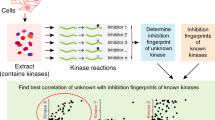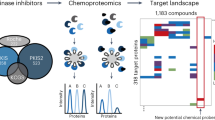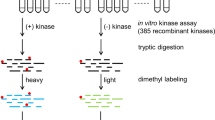Abstract
Small-molecule protein kinase inhibitors are widely used to elucidate cellular signaling pathways and are promising therapeutic agents. Owing to evolutionary conservation of the ATP-binding site, most kinase inhibitors that target this site promiscuously inhibit multiple kinases. Interpretation of experiments that use these compounds is confounded by a lack of data on the comprehensive kinase selectivity of most inhibitors. Here we used functional assays to profile the activity of 178 commercially available kinase inhibitors against a panel of 300 recombinant protein kinases. Quantitative analysis revealed complex and often unexpected interactions between protein kinases and kinase inhibitors, with a wide spectrum of promiscuity. Many off-target interactions occur with seemingly unrelated kinases, revealing how large-scale profiling can identify multitargeted inhibitors of specific, diverse kinases. The results have implications for drug development and provide a resource for selecting compounds to elucidate kinase function and for interpreting the results of experiments involving kinase inhibitors.
This is a preview of subscription content, access via your institution
Access options
Subscribe to this journal
Receive 12 print issues and online access
$209.00 per year
only $17.42 per issue
Buy this article
- Purchase on Springer Link
- Instant access to full article PDF
Prices may be subject to local taxes which are calculated during checkout





Similar content being viewed by others
References
Fabian, M.A. et al. A small molecule-kinase interaction map for clinical kinase inhibitors. Nat. Biotechnol. 23, 329–336 (2005).
Karaman, M.W. et al. A quantitative analysis of kinase inhibitor selectivity. Nat. Biotechnol. 26, 127–132 (2008).
Fedorov, O. et al. A systematic interaction map of validated kinase inhibitors with Ser/Thr kinases. Proc. Natl. Acad. Sci. USA 104, 20523–20528 (2007).
Bain, J. et al. The selectivity of protein kinase inhibitors: a further update. Biochem. J. 408, 297–315 (2007).
Davies, S.P., Reddy, H., Caivano, M. & Cohen, P. Specificity and mechanism of action of some commonly used protein kinase inhibitors. Biochem. J. 351, 95–105 (2000).
Bain, J., McLauchlan, H., Elliott, M. & Cohen, P. The specificities of protein kinase inhibitors: an update. Biochem. J. 371, 199–204 (2003).
Ma, H., Deacon, S. & Horiuchi, K. The challenge of selecting protein kinase assays for lead discovery optimization. Expert Opin. Drug Discov. 3, 607–621 (2008).
Smyth, L.A. & Collins, I. Measuring and interpreting the selectivity of protein kinase inhibitors. J. Chem. Biol. 2, 131–151 (2009).
Goldstein, D.M., Gray, N.S. & Zarrinkar, P.P. High-throughput kinase profiling as a platform for drug discovery. Nat. Rev. Drug Discov. 7, 391–397 (2008).
Miduturu, C.V. et al. High-throughput kinase profiling: a more efficient approach toward the discovery of new kinase inhibitors. Chem. Biol. 18, 868–879 (2011).
Daub, H., Specht, K. & Ullrich, A. Strategies to overcome resistance to targeted protein kinase inhibitors. Nat. Rev. Drug Discov. 3, 1001–1010 (2004).
Morphy, R., Kay, C. & Rankovic, Z. From magic bullets to designed multiple ligands. Drug Discov. Today 9, 641–651 (2004).
Metz, J.T. et al. Navigating the kinome. Nat. Chem. Biol. 7, 200–202 (2011).
Dodson, C.A. et al. Crystal structure of an Aurora-A mutant that mimics Aurora-B bound to MLN8054: insights into selectivity and drug design. Biochem. J. 427, 19–28 (2010).
Graczyk, P.P. Gini coefficient: a new way to express selectivity of kinase inhibitors against a family of kinases. J. Med. Chem. 50, 5773–5779 (2007).
Bamborough, P., Drewry, D., Harper, G., Smith, G.K. & Schneider, K. Assessment of chemical coverage of kinome space and its implications for kinase drug discovery. J. Med. Chem. 51, 7898–7914 (2008).
Faivre, S., Djelloul, S. & Raymond, E. New paradigms in anticancer therapy: targeting multiple signaling pathways with kinase inhibitors. Semin. Oncol. 33, 407–420 (2006).
Morphy, R. Selectively nonselective kinase inhibition: striking the right balance. J. Med. Chem. 53, 1413–1437 (2010).
Knight, Z.A., Lin, H. & Shokat, K.M. Targeting the cancer kinome through polypharmacology. Nat. Rev. Cancer 10, 130–137 (2010).
Cockerill, S. et al. Indazolylamino quinazolines and pyridopyrimidines as inhibitors of the EGFR and c-erbB-2. Bioorg. Med. Chem. Lett. 11, 1401–1405 (2001).
Lapenna, S. & Giordano, A. Cell cycle kinases as therapeutic targets for cancer. Nat. Rev. Drug Discov. 8, 547–566 (2009).
Zhang, Q. et al. Discovery of EGFR selective 4,6-disubstituted pyrimidines from a combinatorial kinase-directed heterocycle library. J. Am. Chem. Soc. 128, 2182–2183 (2006).
Lee, J.C. et al. A protein kinase involved in the regulation of inflammatory cytokine biosynthesis. Nature 372, 739–746 (1994).
Cuny, G.D. et al. Structure-activity relationship study of acridine analogs as haspin and DYRK2 kinase inhibitors. Bioorg. Med. Chem. Lett. 20, 3491–3494 (2010).
Huertas, D. et al. Antitumor activity of a small-molecule inhibitor of the histone kinase Haspin. Oncogene published online, doi:10.1038/onc.2011.335 (1 August 2011).
Patnaik, D. et al. Identification of small molecule inhibitors of the mitotic kinase haspin by high-throughput screening using a homogeneous time-resolved fluorescence resonance energy transfer assay. J. Biomol. Screen. 13, 1025–1034 (2008).
Mencher, S.K. & Wang, L.G. Promiscuous drugs compared to selective drugs (promiscuity can be a virtue). BMC Clin. Pharmacol. 5, 3 (2005).
Liao, J.K., Seto, M. & Noma, K. Rho kinase (ROCK) inhibitors. J. Cardiovasc. Pharmacol. 50, 17–24 (2007).
Yarrow, J.C., Totsukawa, G., Charras, G.T. & Mitchison, T.J. Screening for cell migration inhibitors via automated microscopy reveals a Rho-kinase inhibitor. Chem. Biol. 12, 385–395 (2005).
Knight, Z.A. & Shokat, K.M. Features of selective kinase inhibitors. Chem. Biol. 12, 621–637 (2005).
Fedorov, O., Muller, S. & Knapp, S. The (un)targeted cancer kinome. Nat. Chem. Biol. 6, 166–169 (2010).
Huse, M. & Kuriyan, J. The conformational plasticity of protein kinases. Cell 109, 275–282 (2002).
Manning, G., Whyte, D.B., Martinez, R., Hunter, T. & Sudarsanam, S. The protein kinase complement of the human genome. Science 298, 1912–1934 (2002).
Yee, T.W. & Hastie, T.J. Reduced-rank vector generalized linear models. Stat. Modelling 3, 15–41 (2003).
van der Loo, M.P.J. Distribution-based outlier detection for univariate data. Discussion paper 10003 (Statistics Netherlands, The Hague, 2010).
Cheng, Y. & Prusoff, W.H. Relationship between the inhibition constant (K1) and the concentration of inhibitor which causes 50 per cent inhibition (I50) of an enzymatic reaction. Biochem. Pharmacol. 22, 3099–3108 (1973).
Acknowledgements
We gratefully acknowledge B. Turk, A. Andrews and members of the Peterson laboratory for comments on the manuscript and R. Hartman of Reaction Biology Corp. for developing the Kinase Inhibitor Resource (KIR) web application tool. This work was supported by a W.W. Smith Foundation Award, funding from the Keystone Program in Head and Neck Cancer of Fox Chase Cancer Center and by US National Institutes of Health awards RO1 GM083025 to J.R.P. and P30 CA006927 to Fox Chase Cancer Center. HotSpot technology development was partially supported by the US National Institutes of Health (RO1 HG003818 and R44 CA114995 to H.M.).
Author information
Authors and Affiliations
Contributions
The study was conceived by J.R.P., S.W.D. and H.M., experimental data was collected by S.W.D., statistical analysis was performed by K.D., data were analyzed by T.A. and J.R.P. with input from S.W.D. and H.M., and the manuscript was written by J.R.P. with input from the other authors.
Corresponding author
Ethics declarations
Competing interests
S.W.D. and H.M. are current employees of Reaction Biology Corporation.
Supplementary information
Supplementary Text and Figures
Supplementary Tables 1,2,4,5 and Supplementary Figures 1–5 (PDF 10400 kb)
Supplementary Table 3
Complete pairwise kinase-compound activity dataset. (XLS 967 kb)
Rights and permissions
About this article
Cite this article
Anastassiadis, T., Deacon, S., Devarajan, K. et al. Comprehensive assay of kinase catalytic activity reveals features of kinase inhibitor selectivity. Nat Biotechnol 29, 1039–1045 (2011). https://doi.org/10.1038/nbt.2017
Received:
Accepted:
Published:
Issue Date:
DOI: https://doi.org/10.1038/nbt.2017
This article is cited by
-
Multidta: drug-target binding affinity prediction via representation learning and graph convolutional neural networks
International Journal of Machine Learning and Cybernetics (2024)
-
Chemogenetics for cell-type-specific modulation of signalling and neuronal activity
Nature Reviews Methods Primers (2023)
-
MAP4Ks inhibition promotes retinal neuron regeneration from Müller glia in adult mice
npj Regenerative Medicine (2023)
-
New small molecules in dermatology: for the autoimmunity, inflammation and beyond
Inflammation Research (2023)
-
Effect of Modification on Quality Parameters of Jackfruit (Atrocarpus heterophyllus) Seed Starch to Valorize its Food Potential and In-Silico Investigation of the Pharmacological Compound Against Salmonellosis
Waste and Biomass Valorization (2023)



